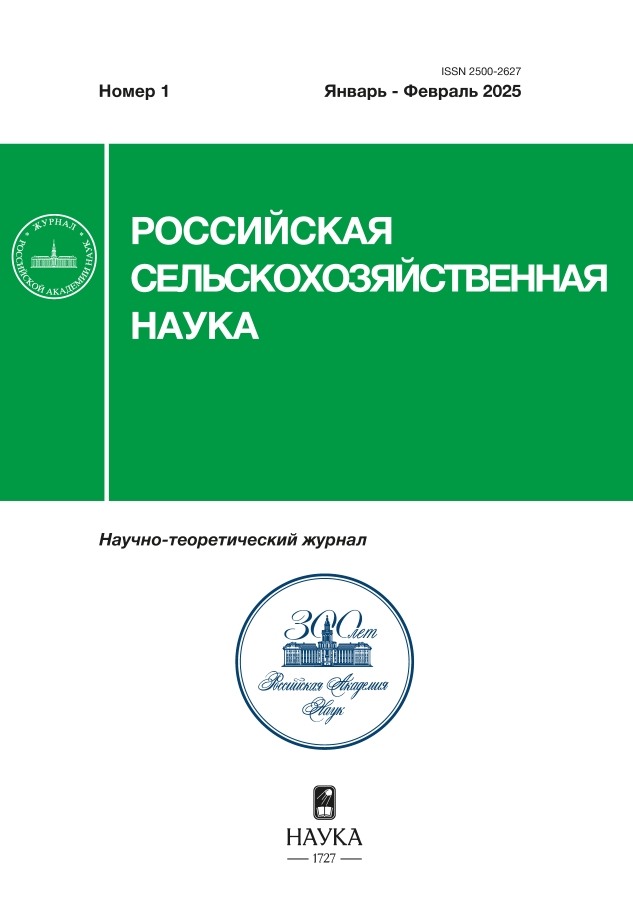Characterisation of modern Russian spring soft wheat varieties for resistance to yellow rust
- Авторлар: Gultyaeva E.I.1, Shaydayuk E.L.1, Levitin M.M.1
-
Мекемелер:
- All-Russian Research Institute of Plant Protection
- Шығарылым: № 1 (2025)
- Беттер: 21-26
- Бөлім: Crop production, plant protection and biotechnology
- URL: https://journal-vniispk.ru/2500-2627/article/view/292008
- DOI: https://doi.org/10.31857/S2500262725010042
- EDN: https://elibrary.ru/CSJSNY
- ID: 292008
Дәйексөз келтіру
Аннотация
The study was conducted to study the genetic diversity of released varieties of spring soft wheat for resistance to yellow rust to assess their potential in genetic protection against Puccinia striiformis West. The material consisted 86 varieties included for the first time in the State Register of Breeding Achievements of the Russian Federation in 2019–2023. Four populations of P. striiformis were used to evaluate seedling resistance. They differed among themselves by geographical origin (Leningrad, Dagestan, Krasnodar, Novosibirsk) and by virulence to differentiators with genes Yr1, Yr2, Yr4, Yr7, Yr27, Yr32, YrSD and YrN D. Only six cultivars Odeta, KVS Jetstream, Nadira, Pequeso, Sviyaga, Hazineh (7 %) showed resistance response to all populations. Molecular markers were used to postulate ten Yr genes Yr5, Yr7, Yr9, Yr10, Yr15, Yr17, Yr18, Yr24, Yr40 and Yr60 and wheat-rye translocation 1AL.1RS with unknown Yr-gene. Isogenic Avocet lines and varieties with identifiable genes were used as positive controls. No highly efficient genes Yr5, Yr10, Yr15, Yr24 and Yr40 and genes Yr7 and Yr60 with varying efficiency were found in the studied varieties. Genes Yr9, Yr17, Yr18 had high representation in the studied and moderate the wheat-rye translocation 1AL.1RS with unidentified Yr gene. The analysis indicates low genetic diversity of Russian spring wheat varieties in terms of resistance to yellow rust and the need for advanced breeding for resistance to P. striiformis.
Негізгі сөздер
Толық мәтін
Авторлар туралы
E. Gultyaeva
All-Russian Research Institute of Plant Protection
Хат алмасуға жауапты Автор.
Email: eigultyaeva@gmail.com
доктор биологических наук
Ресей, 3, Podbelsky Hwy, Pushkin, Saint Petersburg, 196608E. Shaydayuk
All-Russian Research Institute of Plant Protection
Email: eigultyaeva@gmail.com
кандидат биологических наук
Ресей, 3, Podbelsky Hwy, Pushkin, Saint Petersburg, 196608M. Levitin
All-Russian Research Institute of Plant Protection
Email: eigultyaeva@gmail.com
доктор биологических наук, академик РАН
Ресей, 3, Podbelsky Hwy, Pushkin, Saint Petersburg, 196608Әдебиет тізімі
- Генетическая защищенность сортов озимой пшеницы от ржавчинных болезней / Л. А. Беспалова, И. Б. Аблова, Ж. Н. Худокормова и др. // Рисоводство. 2019. Т. 4. № 45. С. 30–37.
- Гультяева Е. И., Шайдаюк Е. Л. Характеристика северо-западной и северокавказской популяций Puccinia striiformis f. sp. tritici по вирулентности и микросателлитным локусам в 2022 году // Микология и фитопатология. 2024. Т. 58. № 4. С. 327–338. doi: 10.31857/S0026364824040062.
- Получение и характеристика линии мягкой пшеницы (Тулайковская 10 × Саратовская 29) с интрогрессией хромосомы пырея Thinopyrum intermedium 6Agi2 / Ю. Н. Иванова, К. К. Розенфрид, А. И. Стасюк и др. // Вавиловский журнал генетики и селекции. 2021. Т. 25. Вып. 7. C. 701–712. doi: 10.18699/VJ21.080.
- Зеленева Ю. В., Судникова В. П., Бучнева Г. Н. Иммунологическая характеристика сортов озимой мягкой пшеницы в условиях ЦЧР // Труды Кубанского государственного аграрного университета. 2022. № 96. С. 95–99. doi: 10.21515/1999-1703-96-95-99.
- Источники устойчивости к желтой ржавчине (возбудитель Puccinia striiformis West.) Среди селекционного и коллекционного материала озимой пшеницы ФГБНУ «АНЦ «Донской» / Г. В. Волкова, И. П. Матвеева, Т. Г. Дерова и др. // Зерновое хозяйство России. 2020. № 4. C. 69–76. doi: 10.31367/2079-8725-2020-70-4-69-76.
- Gultyaeva E. I., Shaydayuk E. L. Resistance of modern Russian winter wheat cultivars to yellow rust // Plants. 2023. Vol. 12. No. 19. Article 3471. URL: https://www.mdpi.com/2223–7747/12/19/3471 (дата обращения: 12.12.2024). doi: 10.3390/plants12193471.
- Государственный реестр сортов и гибридов сельскохозяйственных растений, допущенных к использованию: официальное издание. М.: ФГБНУ «Росинформагротех», 2024. 620 с.
- Генетическое разнообразие перспективных образцов яровой мягкой пшеницы российской и казахстанской селекции по устойчивости к бурой и желтой ржавчинам / Е. И. Гультяева, Е. Л. Шайдаюк, В. В. Веселова и др. // Российская сельскохозяйственная наука. 2024. № 4. С. 43–48. doi: 10.31857/S2500262724020087.
- McIntosh R. A., Wellings C. R., Park R. F. Wheat rusts. An atlas of resistance genes. CSIRO Australia, Kluwer: Acad. Publ., Dordrecht, the Netherlands, 1995. 213 p.
- Rani R., Singh R., Yadav N. R. Evaluating stripe rust resistance in Indian wheat genotypes and breeding lines using molecular markers // Comptes Rendus Biologies. 2019. Vol. 342. P. 154–174. doi: 10.1016/j.crvi.2019.04.002.
- Mas Wheat. URL: https://maswheat.ucdavis.edu/ (дата обращения: 24.12.2024).
- PCR-based markers for detection of different sources of 1AL.1RS and 1BL.1RS wheat–rye translocations in wheat background / Y. Weng, P. Azhaguvel, R. N. Devkota, et al. // Plant Breeding. 2007. Vol. 126. No. 5. P. 482–486. doi: 10.1111/j.1439-0523.2007.01331.x.
- Dorokhov D. B., Cloquet E. A. Rapid and economic technique for RAPD analysis of plant genomes Fast and economical technology of RAPD analysis of plant genomes // Russian Journal of Genetics. 1997. Vol. 33. P. 358–365.
- Permanent spreading of 1RS.1AL and 1RS.1BL translocations in modern wheat breeding / V. A. Korobkova, L. A. Bespalova, A. S. Yanovsky, et al. // Plants (Basel). 2023. Vol. 12. No. 6. Article 1205. URL: https://www.mdpi.com/2223–7747/12/6/1205 (дата обращения: 12.12.2024). doi: 10.3390/plants12061205.
Қосымша файлдар










